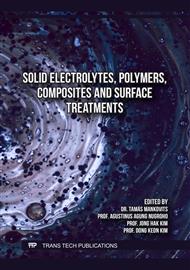[1]
PlasticsEurope, Plastics – the Facts 2022, PlasticsEurope AISBL, Brussels, 2022.
Google Scholar
[2]
PlasticsEurope, Plastics – the Facts 2023, PlasticsEurope AISBL, Brussels, 2023.
Google Scholar
[3]
F. Ronkay, B. Molnár, D. Gere, T. Czigány, Plastic waste from marine environment: Demonstration of possible routes for recycling by different manufacturing technologies, Waste Management. 119 (2021) 101-110.
DOI: 10.1016/j.wasman.2020.09.029
Google Scholar
[4]
R. Geyer, J.R. Jambeck, K.L. Law, Production, use, and fate of all plastics ever made, Science Advances. 3 (2017) e1700782.
DOI: 10.1126/sciadv.1700782
Google Scholar
[5]
F. Ronkay, D. Gere, E. Slezák, E. Szabó, G. Marosi, K. Bocz, Recycled PET packaging materials of improved toughness— Importance of devitrification of the rigid amorphous fraction, Macromolecular Materials and Engineering. (2024) 2400219.
DOI: 10.1002/mame.202400219
Google Scholar
[6]
P. van den Tempel, F. Picchioni, Polymer recycling: A comprehensive overview and future outlook, Recycling. 10 (2025) 1-34.
DOI: 10.3390/recycling10010001
Google Scholar
[7]
V.S. Cecon, G.W. Curtzwiler, K.L. Vorst, A study on recycled polymers recovered from multilayer plastic packaging films by solvent-targeted recovery and precipitation (STRAP), Macromolecular Materials and Engineering. 307 (2022) 2200346.
DOI: 10.1002/mame.202200346
Google Scholar
[8]
T. Li, G. Theodosopoulos, C. Lovell, A. Loukodimou, K.K. Maniam, S. Paul, Progress in solvent-based recycling of polymers from multilayer packaging, Polymers. 16 (2024) 1670.
DOI: 10.3390/polym16121670
Google Scholar
[9]
D. Gere, T. Czigány, Future trends of plastic bottle recycling: Compatibilization of PET and PLA, Polymer Testing. 81 (2020) 106160.
DOI: 10.1016/j.polymertesting.2019.106160
Google Scholar
[10]
J. Maris, S. Bourdon, J.-M. Brossard, L. Cauret, L. Fontaine, V. Montembault, Mechanical recycling: Compatibilization of mixed thermoplastic wastes, Polymer Degradation and Stability. 147 (2018) 245-266.
DOI: 10.1016/j.polymdegradstab.2017.11.001
Google Scholar
[11]
A. Dorigato, Recycling of polymer blends, Advanced Industrial and Engineering Polymer Research. 4 (2021) 53-69.
DOI: 10.1016/j.aiepr.2021.02.005
Google Scholar
[12]
R. Muthuraj, M. Misra, A.K. Mohanty, Biodegradable compatibilized polymer blends for packaging applications: A literature review, Journal of Applied Polymer Science. 135 (2018) 45726.
DOI: 10.1002/app.45726
Google Scholar
[13]
H. Zhang, W. Guo, Y. Yu, B. Li, C. Wu, Structure and properties of compatibilized recycled poly(ethylene terephthalate)/linear low density polyethylene blends, European Polymer Journal. 43 (2007) 3662-3670.
DOI: 10.1016/j.eurpolymj.2007.05.001
Google Scholar
[14]
S.K. Taghavi, H. Shahrajabian, H.M. Hosseini, Detailed comparison of compatibilizers MAPE and SEBS-g-MA on the mechanical/thermal properties, and morphology in ternary blend of recycled PET/HDPE/MAPE and recycled PET/HDPE/SEBS-g-MA, Journal of Elastomers & Plastics. 50 (2017) 13-35.
DOI: 10.1177/0095244317698738
Google Scholar
[15]
R.S. Chen, M.H. Ab Ghani, M.N. Salleh, S. Ahmad, S. Gan: Influence of blend composition and compatibilizer on mechanical and morphological properties of recycled HDPE/PET blends, Materials Sciences and Applications. 5 (2014) 943-952.
DOI: 10.4236/msa.2014.513096
Google Scholar
[16]
M. Kaci, A. Benhamida, S. Cimmino, C. Silvestre, C. Carfagna, Waste and virgin LDPE/PET blends compatibilized with an ethylene-butyl acrylate-glycidyl methacrylate (EBAGMA) Terpolymer, 1., Macromolecular Materials and Engineering. 290 (2005) 987-995.
DOI: 10.1002/mame.200500217
Google Scholar



